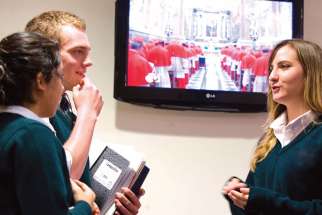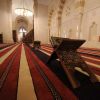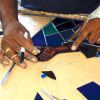Students inspired to play like champs
HAMILTON, ONT. - At Hamilton’s St. Thomas More Catholic Secondary School, members of the senior soccer teams are learning more than just tactics, strategy and skills specific to their sport; they’re learning how faith contributes to their game.
School chaplaincy engages students in the faith
The role of chaplaincy in Catholic education has a long history. When Catholic high schools were founded, by religious orders, it was often with great sacrifice that a community would identify a chaplain who had theological training, often a priest or professed religious. Those early communities understood the value of chaplaincy.
Students split on religious studies
BRAMPTON, ONT. - The law might give some students a pass from religious studies in Catholic high schools, but that doesn’t mean non-Catholic students are opting out of religion class.
St. Martin’s Manor unlocks future for teen moms
HAMILTON, ONT. - The future is a kind of massive cloud of the unknown, a mix of the probable and the impossible, that is constantly smothering the present. Every life has a little history, but lives are lived for, in and with the future.
Muslim prayer room welcomed at Catholic school
Concerns that the establishment of a prayer room, requested by Muslim students, at a London, Ont., Catholic high school will water down the school’s Catholic faith are just plain wrong, says the school board’s education director.
“First of all it’s a prayer room, it’s not named after a particular faith,” said Wilma de Rond, director of education for the London District Catholic School Board (LDCSB). “When a request comes from another faith there is no request for us to provide any sort of accommodation for them that in some way impacts our faith.”
Although de Rond dismisses the concern, it has been circulating in the media since news about the second floor prayer room at Mother Teresa Catholic Secondary School broke earlier this month.
Earlier this year about 25 students at the southwestern Ontario school, with a student body of about 1,400, submitted a request to the principal for a room for Islamic prayer during lunch period on Fridays. This is the first religious accommodation request of its kind for the board, said de Rond.
The Ministry of Education’s Developing and Implementing Equity and Inclusive Education Policies in Ontario Schools requires all publicly funded schools in the province to provide religious accommodations when requested by students or their parents, provided that doing so does not cause excessive grievance to the school. As long as it does not place burdensome costs on the school, interrupt instructional time or directly conflict with existing policies/practices, the school is obliged to do so, as is the case in London.
“We are trying to work in a way that is respectful for our own faith, our Catholic faith, but also respectful of the fact that these young people have made a request that they want to be able to follow their faith,” said de Rond.
The goal, according to de Rond, is to outfit the room in a way that will satisfy the requirements for the Muslim students while maintaining an atmosphere where other students can use the room. Although no other groups have requested use of the room, it will be available outside the time allocated to the Muslim group.
De Rond sees this as nothing more than a learning experience. She did admit, though, that not everyone views this matter through that lens.
“Unfortunately there have been some concerns expressed in terms of racial comments which again is most unfortunate and is not in keeping with who we are as Catholic in terms of beliefs of our call to love one another,” she said. “There has also been expressions of very positive affirmation of this decision as well.”
The prayer room at Mother Teresa was expected to be completed by the end of September, although de Rond stressed there were still details to be worked out.
“It’s interesting for us to learn about a particular faith so it’s been a good thing for us to be able to have these conversations with the students and their parents and so we are proceeding forward in terms of our understanding of what will occur, how they pray, what they pray for (and) what the words of the prayers will be,” she said. “It’s increasing our own understanding, which is a good thing.”
Other Catholic boards are sure to receive similar requests, and are also seeing this as an opportunity.
“It’s not an imposition on us at all,” said Michael Way Skinner, co-ordinater of religion, family life and equity at the York Catholic District School Board. “It is an expression of who we are as Catholics. When we as a Catholic community accept that call to be welcoming to people of other faiths we are actually putting into practice what we are trying to teach the kids in the classroom and it’s by what we do, it’s by our fruits that they’ll judge us, not by what we say to them and what we try to teach to them off chalkboards or smartboards.”
Although he supports the idea, Way Skinner did admit his board might not be able to fulfill similar requests. It’s not that the board is unwilling, rather, most York Region schools are already pushing capacity and allocating an entire room for a weekly prayer service would cause excessive grievance.
“It might be a space like in the library or somewhere like that that is a quiet space for the students to gather to pray if they wanted to,” said Way Skinner.
Stained glass, a time-honoured tradition
TORONTO - Tools, training and talent aside, the one thing you really need to make a piece of stained glass is time.
“A stained glass window, if it is truly a stained glass piece, you put in about five months,” said Joseph Aigner, owner of Artistic Glass since it opened in 1971. “That’s realistic. If it is just coloured glass and leading, that’s different.”
For a piece to be genuine stained glass one must paint it, heat it in a kiln to 677 degrees Celsius, and repeat as necessary. Each time this is done, four times on average to produce a detailed face, it takes about 16 hours because once the glass is heated it requires half a day to cool before a second coat of paint can be applied.
Not only is this the defining characteristic of stained glass, it is also a very time-consuming stage of the process — one which many people never associate with the semi-transparent art work.
“A lot of people have the imagination that this is what stained glass is,” said Aigner, pointing to large piece of coloured glass that had been tinted during the manufacturing of the solid glass sheet. “You have to then inform them that what they have is coloured glass leaded together.”
Aside from the paint and bake component, the process of making a piece of artistically leaded glass — be it clear, stained, coloured or more commonly a combination — is the same.
A design is composed and once it satisfies the collective vision of those involved, a full-scale version is drawn up. One of these drawings is then taken and, using wide-blade scissors to compensate for the necessary gaps for leading, cut into the individual sections. These patterns, labelled for further reference, are used to cut out each piece of glass by hand.
Leading is when the multiple sections of glass are bound together. To do this a full-scale pattern is laid out on a table which has one corner fitted with a molding boarder. The molding, which sits higher than the table’s surface, provides the artist with a ridged edge to pin the glass pieces against as stripes of lead are used to frame each.
Once the entire project is laid out and leaded, including the outer edge, all joints are soldered together and then sealed with a specially mixed glue.
How long this all takes varies as much as the number of combinations you can make.
“(It) depends on how many pieces are in it, how difficult it is,” said Aigner, who picked up the craft as a child while working at his family’s glass shop in Germany. “When we make a church project it can take sometimes up to two years to complete.”
There are two major reasons why stained glass windows for churches take so long, said Aigner. First, priests want real stained glass, although most accept a mixture of coloured and stained to keep costs down. The second reason, church projects are large, complex and often multi-window assignments intended to please hundreds of parishioners meaning the design phase is rarely a first-draft success.
“The most challenging thing is to get the design approved,” said Aigner, who is four months into an eight-window project, each representing one of the Beatitudes, for St. Augustine Catholic High School in Markham, Ont. “We had a little bit of a problem finding images for the Beatitudes. I had a little trouble getting a concept ... but now we have a beautiful design.”
Award-winning paper ‘Off the Wall’
TORONTO – Off the Wall, the Pope John Paul II Catholic Secondary School student newspaper, has won the general excellence award in the first Catholic Register Student Newspaper Awards.








